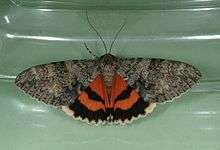Catocala amatrix
Catocala amatrix, the sweetheart underwing, is a moth of the family Erebidae. The species can be found from Nova Scotia, south through Connecticut to Florida and west through Texas and Oklahoma to Arizona and north to Montana, Minnesota, and Ontario.
| Sweetheart underwing | |
|---|---|
 | |
| Scientific classification | |
| Kingdom: | Animalia |
| Phylum: | Arthropoda |
| Class: | Insecta |
| Order: | Lepidoptera |
| Superfamily: | Noctuoidea |
| Family: | Erebidae |
| Genus: | Catocala |
| Species: | C. amatrix |
| Binomial name | |
| Catocala amatrix | |
| Synonyms | |
| |
An exhibition model done by the Denton Brothers of Wellesley, Massachusetts was discovered in a consignment shop in Flagler Beach, Florida on September 12, 2013 by Brittany Durocher, a resident of that city. It was collected by the Denton Brothers in Virginia and named Catocala amatrix virginurus.
The wingspan is 75–95 mm. The moths flies from August to October depending on the location.
The larvae feed on Populus deltoides, Populus grandidentata, Populus nigra, Populus tremuloides, and Salix nigra.
Gallery
 picture of the specimen found by Ms. Durocher
picture of the specimen found by Ms. Durocher Attribution to the Denton Brothers
Attribution to the Denton Brothers
- Lectotype of Catocala nurus, now considered to be a synonym of Catocala amatrix
References
- Yu, Dicky Sick Ki. "Catocala amatrix (Hubner 1813)". Home of Ichneumonoidea. Taxapad. Archived from the original on March 15, 2016. Retrieved 2015-11-11.
| Wikispecies has information related to Catocala amatrix |
| Wikimedia Commons has media related to Catocala amatrix. |